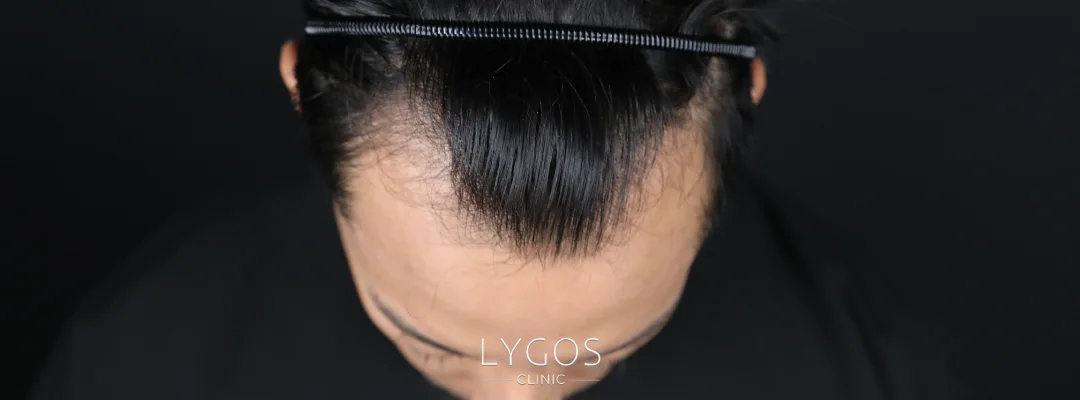How to Stop DHT Hair Loss | Reducing DHT Naturally

Chose Your Topic
How to Stop DHT Hair Loss
Hair loss is a common problem for both men and women. One of the main factors behind androgenetic alopecia (male pattern baldness) and female pattern hair loss is DHT (Dihydrotestosterone). So, how to stop DHT hair loss? In this article, we will explore the effects of DHT on hair loss and how you can control it using both natural and scientific methods.

What is DHT and How Does It Cause Hair Loss?
DHT is a derivative of the hormone testosterone and has many important functions in the body. However, high levels of DHT can cause hair follicles to shrink and weaken over time, leading to thinning hair and eventually hair loss.
To answer the question of how to stop DHT hair loss, it’s important to first understand its mechanism. DHT binds to androgen receptors in hair follicles and shortens their growth phase. This disrupts the natural hair cycle and reduces the production of new hair.
Effects of DHT on Hair Follicles
Hair follicles are responsible for the hair growth and shedding cycle. When DHT levels become high, follicles shrink and hair strands begin to thin. This shortens the lifespan of hair and increases the rate of hair loss.
Research shows that in men, DHT-sensitive follicles on the forehead and crown are damaged more quickly. In women, hair loss is generally more diffuse, reducing overall hair density.
Therefore, those asking “How can I stop DHT hair loss?” need to both protect hair follicles and balance DHT levels.

How to Stop DHT Hair Loss?
We can answer the question by combining scientific and natural methods:
- Use DHT-Blocking Products: Shampoos, serums, and topical treatments can reduce the damage DHT causes to hair follicles.
- Natural DHT Inhibitors: Herbal solutions and supplements can help balance DHT production in the body.
- Nutrition and Supplements: Zinc, B vitamins, biotin, and omega-3 support overall hair health.
Regular use and a holistic approach are critical in effectively controlling DHT hair loss.
DHT-Blocking Shampoos and Serums
Products that directly block DHT can be effective in preventing hair loss. These often contain ingredients like saw palmetto, ketoconazole, and finasteride:
- Saw Palmetto: A plant-based DHT inhibitor that helps protect hair follicles.
- Ketoconazole: Although antifungal, it can help reduce DHT levels in hair follicles.
- Topical Finasteride: Blocks DHT production, reducing hair loss.
Regular and correct use of these products directly addresses the question of how to stop DHT hair loss.

Reducing DHT Naturally
For those who prefer to avoid chemical products, natural methods are also effective. These aim to reduce DHT production in the body and strengthen hair follicles:
- Green Tea: Contains catechins that inhibit DHT production.
- Onion Juice and Garlic: Antioxidants that support hair follicles.
- Peppermint and Rosemary Oils: Promote hair growth when applied topically.
With consistent use, these natural solutions can slow hair loss and support healthy hair.
Nutrition and Supplements for DHT Control
Diet directly affects hair health and DHT levels. Some nutrients help reduce DHT production:
- Zinc: Helps balance DHT and protect hair follicles.
- Omega-3 Fatty Acids: Nourish hair follicles.
- Biotin and B Vitamins: Support strong and healthy hair growth.
Processed foods, sugar, and excessive fat can increase DHT levels. A healthy diet can offer a natural solution to controlling DHT hair loss.
How to Stop DHT Hair Loss Frequently Asked Questions (FAQ)
Yes. DHT binds to androgen receptors in hair follicles, causing them to shrink and hair to thin. This process is especially pronounced in male pattern hair loss.
Use DHT-blocking shampoos and serums, natural methods, a healthy diet, and supplements. Regular care and the right product choices are key.
Yes. Shampoos containing saw palmetto, ketoconazole, or finasteride reduce DHT and protect hair follicles. Consistent use delivers effective results.
Yes. Natural solutions like green tea, peppermint oil, and rosemary oil can help balance DHT. However, consistent use and patience are required for noticeable results.



